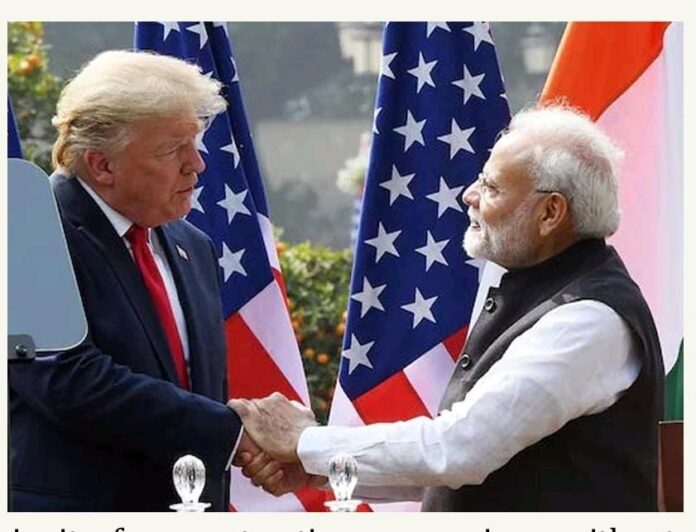Amit Pandey

Prime Minister Narendra Modi and former U.S. President Donald Trump shared a well-documented camaraderie, marked by a mutual understanding of their nationalistic agendas—Modi’s vision of a “Great India” and Trump’s relentless pursuit of “America First.” However, despite the public display of warmth, their interactions were not devoid of friction, as several policy decisions by the Trump administration directly impacted India and its interests. The upcoming diplomatic engagement was therefore crucial, as both leaders had their own set of priorities, and the balance of negotiations was expected to be a high-stakes affair.
One of the most contentious issues was the status of Indian migrants in the U.S. Trump’s stringent immigration policies, aimed at reshaping America’s demographic and economic landscape, placed many undocumented Indians in a vulnerable position. While their infiltration through illegal routes was unquestionably unlawful, the mass deportation drive under Trump’s administration was met with sharp criticism. Many viewed these individuals not as criminals but as desperate people seeking survival and opportunities unavailable in their homeland. The Indian government found itself in a delicate position, as opposing deportations too strongly would be seen as interfering in U.S. domestic policy, while remaining silent would be perceived as abandoning its own people.
The tariff war was another thorny subject. Trump’s imposition of tariffs on Indian goods was not merely an economic maneuver but a calculated move to sustain the supremacy of the U.S. dollar. The American economy thrived on the dominance of the dollar in global trade, and any relaxation in tariffs could inadvertently create space for competing currencies like the euro or yen. This strategic financial play forced India into a tough bargaining position. While Modi’s government was known for its hard-nosed negotiations, going head-to-head with Trump, who prioritized economic nationalism above all else, was a formidable challenge.
Adding another layer of complexity was the issue of Gurpatwant Singh Pannun, the pro-Khalistan separatist. While Modi had raised concerns over the activities of individuals like Pannun, there was little indication that the U.S. would take substantial action. Despite America’s verbal commitments to counter terrorism, its record on dealing with anti-India elements remained questionable. The opposition in India was quick to highlight this inconsistency, questioning why the U.S. had previously allowed figures like Hafiz Saeed to operate despite declaring him a terrorist. If the U.S. truly viewed terrorism as a shared threat, why were Indian concerns sidelined? These contradictions reflected the inherent difficulty India faced in extracting favorable commitments from the American administration.
Beyond these immediate disputes, the larger economic and geopolitical context also played a role. The U.S. was burdened with rising international debt, and Trump’s aggressive trade policies were, in part, an attempt to mitigate economic vulnerabilities. Given this backdrop, America was unlikely to strain ties with India beyond a certain threshold, recognizing the subcontinent as a critical market and strategic partner. However, it was also clear that Trump’s agenda was singularly focused on securing economic and political advantages for the U.S., making negotiations an intricate game of leverage and counter-leverage. Modi’s diplomatic acumen was put to the test in ensuring that India’s interests were protected without unnecessarily escalating tensions.
The challenge lay in maneuvering these complex discussions without yielding too much ground. Modi’s task was to maintain India’s economic standing, ensure protection for Indian workers, and demand accountability on security concerns—all while navigating an administration that prioritized its own gains. The success of this visit depended on how effectively India could turn the tables in its favor, extracting concessions without compromising on its long-term strategic interests. In an era where global politics was defined by transactional diplomacy, Modi’s ability to secure tangible benefits for India amid Trump’s unyielding stance was the ultimate test of his leadership.
Historical Context:
The Indo-U.S. relationship has witnessed several milestones, particularly in defense, trade, and strategic partnerships. From the Civil Nuclear Agreement in 2008 to the 2+2 Ministerial Dialogue initiated in 2018, both nations have reinforced their diplomatic and military cooperation. During Trump’s tenure, India was designated a Major Defense Partner, paving the way for enhanced military collaboration. However, economic friction emerged due to Trump’s tariff policies, pushing India to reassess its trade strategy.
Key Issues in Focus
1. Trade Tariffs: A Stumbling Block?
One of the primary concerns Modi is expected to address is Trump’s imposition of high tariffs on Indian exports. The U.S. has consistently criticized India’s trade policies, labeling it the “tariff king.” According to U.S. Trade Representative data, India’s trade surplus with the U.S. stood at approximately $25 billion in 2019, prompting Trump to demand greater market access for American goods.
Economist Usha Sunil remarks, “Trump’s trade policies were driven by a protectionist agenda. However, given India’s growing economic clout, a more balanced trade agreement is inevitable.” While Modi seeks tariff reductions on key exports such as pharmaceuticals and textiles, Trump remains adamant about ensuring a level playing field for American manufacturers.
India’s global trade policies have also evolved in response. New Delhi has deepened its engagement with the European Union, ASEAN, and Gulf nations to mitigate the risks of unilateral tariff hikes by the U.S. With the ongoing recalibration of global supply chains, Modi is expected to negotiate stronger trade assurances that protect Indian exporters from sudden tariff escalations.
2. Immigration Policies and the Indian Diaspora
Trump’s crackdown on illegal immigration has disproportionately impacted Indian migrants. Several reports indicate that a significant number of Indians enter the U.S. through illegal routes, often referred to as the ‘donkey route.’ While unauthorized migration is a concern, the Indian government has consistently pushed for a more humane approach to deportation procedures.
Moreover, Trump’s restrictions on H-1B visas created uncertainty for Indian IT professionals, a key workforce in Silicon Valley. Experts believe Modi may push for a more favorable visa policy, ensuring job security for Indian expatriates. Political commentator Rajat Sharma argues, “Modi’s challenge is to balance diplomatic negotiations while securing tangible benefits for Indian professionals.”
With a growing demand for skilled workers in the U.S., India is likely to push for a restructured visa framework that benefits both nations. The Biden administration has softened some of Trump’s rigid policies, but a potential Trump comeback in 2024 could reignite restrictive measures, making this issue a critical discussion point.
3. Counter-Terrorism and the Khalistani Challenge
India has repeatedly sought stronger U.S. action against Khalistani elements operating in America. The case of Gurpatwant Singh Pannun, a separatist leader advocating for Khalistan, has been a contentious issue. Despite U.S. assurances on counter-terrorism cooperation, tangible actions against such individuals remain limited.
During a Lok Sabha session, BJP MP Nishikant Dubey alleged that U.S. administrations have historically provided indirect support to Pakistan-backed elements. This meeting presents an opportunity for Modi to reiterate India’s concerns and demand stricter measures against anti-India activities.
Additionally, counter-terrorism collaborations could extend into intelligence-sharing agreements and joint military exercises. With the resurgence of Taliban control in Afghanistan and rising instability in Pakistan, both nations may discuss enhanced security mechanisms to combat terrorism in South Asia.
Strengthening India’s Global Position
Prime Minister Narendra Modi’s diplomatic engagements with the United States follow a well-calibrated strategic agenda, reflecting India’s broader geopolitical aspirations. His focus extends across economic, defense, energy, technology, and strategic alliances, emphasizing India’s role as a global power while securing national interests.
Economic Cooperation: Bridging Trade Imbalances
One of Modi’s primary concerns has been negotiating better trade terms with the U.S., particularly in reducing tariffs and securing greater market access for Indian goods. With India emerging as the world’s fastest-growing major economy, Modi aims to leverage this position to push for fairer trade agreements, especially in technology and manufacturing sectors. The push for a more balanced tariff structure is also crucial to counter trade dependencies and ensure India’s economic resilience against global disruptions.
Defense Procurement: Strengthening Security Ties
India’s strategic military partnership with the U.S. has gained momentum in recent years, with major defense deals involving advanced fighter jets, drones, and missile systems. The Modi government has prioritized defense procurement not just for modernization but also to counter regional threats, particularly from China and Pakistan. The acquisition of American military technology is expected to complement India’s Atmanirbhar Bharat (self-reliant India) initiative, ensuring domestic production and reducing dependence on traditional suppliers like Russia.
Energy Security: Diversifying India’s Supply Chains
The Indo-U.S. energy partnership, especially in liquefied natural gas (LNG) trade, is a crucial aspect of Modi’s agenda. As India seeks to reduce reliance on Middle Eastern energy sources, American LNG provides an alternative, ensuring price stability and energy security. Additionally, collaboration in renewable energy aligns with India’s climate commitments while attracting investments in the green energy sector.
Strategic Alliances: India’s Role in the Indo-Pacific
Amid China’s growing assertiveness, Modi’s diplomatic push aims to solidify India’s position in the Indo-Pacific strategy. By enhancing defense and trade ties with the U.S., India seeks to project itself as a counterbalancing force, ensuring a free and open Indo-Pacific. This aligns with U.S. interests, making India a critical ally in the region.
Technology and Healthcare Collaboration
India is seeking expanded cooperation in AI, cybersecurity, and space exploration, positioning itself as a technology hub. Additionally, post-COVID global health security remains a key focus, with India pushing for greater collaboration in pharmaceutical research and vaccine production to reduce Western dependency on Chinese supply chains.
Modi’s engagement with the U.S. is thus not just about bilateral agreements but about securing India’s long-term strategic interests, balancing economic growth, security concerns, and global influence.
Trump’s Priorities
- Reducing the Trade Deficit: Pressuring India to lower tariffs and open up its markets further.
- Immigration Control: Reinforcing policies that align with his ‘America First’ narrative.
- Strengthening the Dollar: Ensuring the dominance of the U.S. dollar against emerging global currencies.
- Expanding Defense Exports: Securing Indian commitments to purchase American defense technology.
- China Containment Strategy: Reinforcing India’s role in countering China’s economic and military expansion.
- Strengthening the Quad Alliance: Ensuring India remains committed to the U.S.-led Quadrilateral Security Dialogue (Quad).
Challenges and Opportunities in Bilateral Talks
Economic Tensions:
- The U.S. wants greater access to Indian markets, while India seeks lower tariffs on its exports.
- If Trump insists on harsher trade terms, India may diversify its trade partnerships, potentially leaning towards the European Union or ASEAN nations.
Political Balancing Act:
- Modi’s challenge is to extract maximum benefits without compromising India’s strategic autonomy.
- With upcoming elections in both nations, political considerations will heavily influence the negotiations.
Strategic Cooperation vs. Sovereignty:
- India remains cautious about being seen as overly dependent on the U.S.
- Modi will aim to secure benefits without compromising India’s independent foreign policy stance, particularly in its relations with Russia and the Middle East.
Dr. Anil Gupta, a senior political analyst, asserts, “While Trump’s policies are transactional, Modi’s approach is strategic. The key lies in finding common ground where both leaders can claim victory.” Meanwhile, defense analyst Ramesh Sharma believes, “India’s rise as a global military power aligns with U.S. interests, making defense cooperation a likely area of agreement.”
Economist Dr. Manish Verma highlights, “The Modi-Trump meeting will set the tone for future economic engagements. India must ensure that its interests in manufacturing, technology, and energy remain protected while leveraging its growing economic influence.”
The Modi-Trump meeting represents a critical juncture in Indo-U.S. relations. While economic disputes persist, the broader strategic interests of both nations demand cooperation. Modi’s challenge is to secure favorable trade terms while maintaining India’s sovereign interests, whereas Trump aims to reaffirm U.S. economic and security dominance. The outcome of these talks will not only shape future bilateral ties but also influence global geopolitical dynamics. If handled effectively, this engagement could usher in a new era of Indo-U.S. collaboration, strengthening ties in trade, defense, and global security.
( Author is Managing Editor of The Emerging World)


